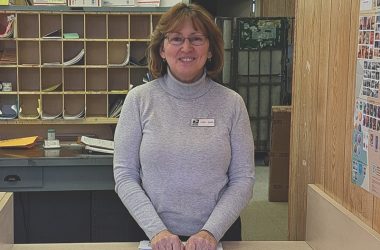by KATE SHUNNEY & TRISH RUDDER

West Virginia Division of Highways map rendering of the southern end of a 522 Bypass.
Morgan County Commissioners and Town of Bath officials have both joined an effort by local business officials to seek changes to state Division of Highways (DOH) plans for a U.S. 522 bypass east of Berkeley Springs.
Commissioners penned a letter to DOH officials on May 7, supporting the bypass but seeking three changes to published plans for the 4-mile, four-lane expressway. Those requests mirror concerns presented to the county and town last week.
Bath mayor Scott Merki asked the Bath town council to allow him to write to the state to request the same changes to the proposed bypass route around Berkeley Springs.
Merki said in a May 1 town council meeting that he wants the bypass design changed to allow traffic coming from Hancock, Md. and Winchester, Va. to continue straight on U.S. 522 rather than a straight route to the bypass as it is currently designed.
“The north and south bounds need to get into town,” Merki said.
Matt Omps, owner of The Country Inn, addressed commissioners on May 2 on behalf of a taskforce formed by the Morgan County-Berkeley Springs Chamber of Commerce. The taskforce was created in response to recently unveiled bypass plans.
State highway officials have said construction of the $64 million bypass and a hospital connector road from U.S. 522 and Fairview Drive are top priority projects to be funded through the state’s new highway bond.
Lori Hansroth, Executive Director of the Chamber of Commerce, said the taskforce is not working against the bypass.
“The committee wasn’t formed to fight the bypass, but to voice concerns,” she said.
“The taskforce is asking for commission support to get the south end redesigned so they’re not forcing all the traffic onto the bypass,” said Omps.
He noted that all traffic on U.S. 522, whether it was local or not, would have to use a new four-lane bypass. DOH plans show 522 dead-ending just south of the 19th Hole club.
“Most bypasses are designed in pretty much a Y – bypass goes one way and the business route goes another,” Omps said.
The working group has also zeroed in on interchanges along the bypass, and how they would affect neighborhoods.
Omps said a proposed at-grade crossing could bring bypass traffic onto roads like Myers Road, which can’t handle trucks or additional traffic.
“That’s pretty much a one-lane road now,” he said.
Commission President Joel Tuttle said some roads would need major upgrades to take bypass traffic.
Tuttle said it’s important that the design “makes sense to us.”
“We’re all on board with fixing this,” said Commissioner Ken Reed. “It needs to be synergistic with what’s going on already.”
Tuttle said the bypass needs to keep tourists coming into town, not going around it.
“Right now we have a lot of people who come here and spend money and we don’t want to mess with that,” he said.
Reed asked Daryl Cowles if the DOH would be “more receptive” if officials focused their comments on one or two aspects of the bypass design, rather than a list of changes.
“Definitely,” Cowles said. He then warned county officials any major changes to the design could cause delays that might threaten funding for the entire project.
“We’ll be asking the DOH to reopen the design on the south end,” Cowles said. Highway contractors are “going rocket speed” to design the northern end of the bypass, said Cowles. “We don’t want to delay the project too long.”
He said he and State Senator Charles Trump could take specific design concerns to DOH officials.
“I think we have to engage with highway engineers and see what the options are,” Cowles said.
Bob Maargraff said signs at the start of a new bypass should direct through-trucks to use the new road, rather than continuing downtown.
Jeanne Mozier said her main concerns were the local people who would have to get on and off the bypass several times each day to get around town, and managing growth along the bypass.
She said the commissioners could do what she called “corridor zoning” to plan for future growth and manage water and sewer needs for new stores, gas stations and restaurants.
County GIS coordinator Stefanie Allemong created a new map of the bypass plans, including local real estate parcel information, which can be viewed on the county’s GIS website.
In their May 7 letter to the DOH, county commissioners wrote: “The MCC desires that as the result of the 522 bypass, the economic viability of the County’s downtown business district along the current 522 be preserved. We further hope that the 522 Bypass will secure the safety and well-being of all residents of the neighborhoods, and travelers along the streets and byways intersected by the 522 Bypass.”
Commissioners asked the DOH to:
–Allow non-truck traffic heading north to proceed along the current 522 to downtown Berkeley Springs without having to get on the bypass
–Allow non-truck traffic heading south from Hancock toward Berkeley Springs to use the current 522 to get into town
–Use signs, traffic control, speed limit and weight restrictions to protect the safety of people in the areas of bypass crossings, particularly on Myers Road, Sugar Hollow Road, Johnson Mill Road and other local roads affected by the bypass.
The DOH held one public comment session on their bypass designs on April 19. Officials said they don’t plan to hold another.
Public comment about the design is being accepted by the DOH through May 21 through the state highway website and by email and mail. Comments can be sent to:
RJ Scites, P.E.
Director, Engineering Division
West Virginia Division of Highways
1334 Smith Street
Charleston, West Virginia 25301
Comments may also be submitted at: http://go.wv.gov/dotcomment.
Maps and basic information about the bypass plans are also posted there.









